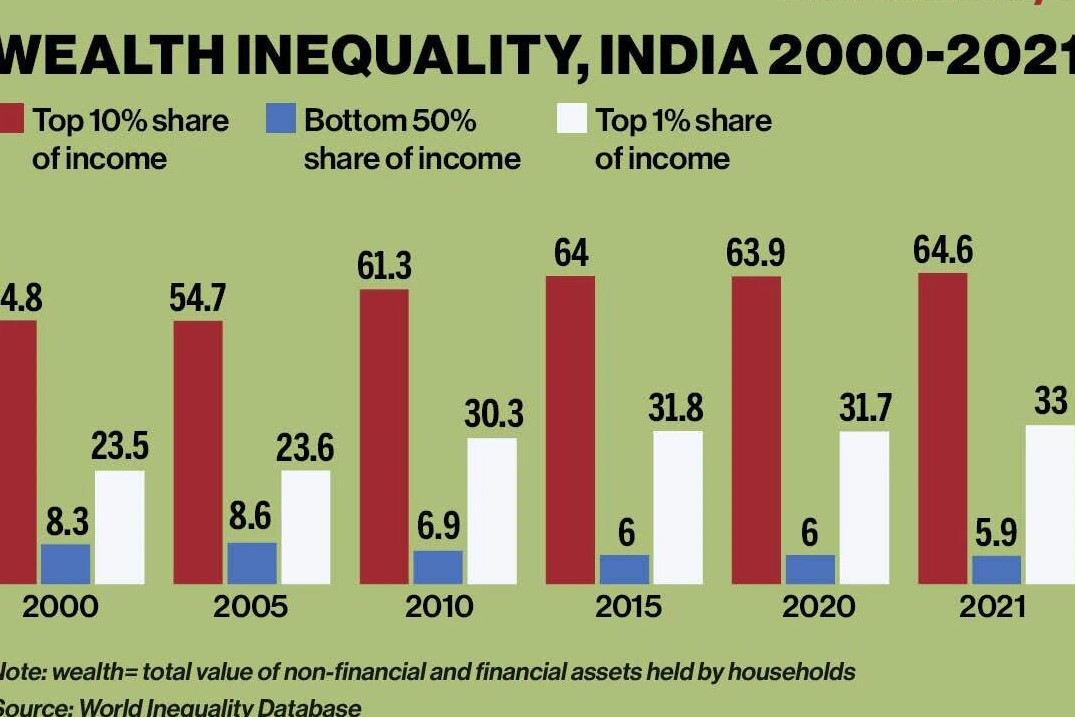By Ranu , Economist


India’s recent economic growth presents a paradox. On one hand, official statistics suggest a resurgent Indian economy, steadily outpacing other major developing economies but on other hand, sector-specific indicators are flashing warning signs.
While much of the world is slowing down, India’s growth seems to be marching forward. In the first quarter of FY24/25 (April-June 2024), India's GDP grew at a remarkable 7.8% year-on-year (y-o-y), continuing a strong trend from FY23/24. However, beneath these glowing statistics lies a different story—one where various indicators of activity in construction, manufacturing, services and agriculture are flashing warning signs.
This contrast paints a picture of two Indias: one marching ahead strongly, and the other grappling with mounting challenges. The puzzling question is, which of these Indias represents the true state of the nation’s economy?
The big gap between GDP and GVA growth rates
To understand this puzzle, it is important to look beyond the GDP growth rate. Gross Domestic Product (GDP) is derived from Gross Value Added (GVA), which calculates the output produced across different sectors – agriculture, construction, mining, manufacturing, and services. Ideally, GDP and GVA growth rates should move in the same direction. However, in recent quarters, GDP growth has not only been substantially higher than GVA growth but has also diverged from GVA growth. This has raised questions about the reliability of the growth narrative.
For instance, while GDP growth increased from 7.7% in FY23/24 to 7.8% in Q1 FY24/25, GVA growth declined from 7.2% in FY23/24 to 6.8% y-o-y in Q1 FY24/25. The reason? A significant contribution from net taxes—taxes collected by the government minus subsidies—has artificially inflated GDP growth. This suggests that the impressive GDP growth might not reflect the actual economic activity happening on the ground.
In a true sense, GVA offers a clearer picture of the economy's health.
Within GVA, economic analysts and the government have highlighted the strong performance of the construction sector due to increased infrastructure spending by the government, a real estate boom and a promising upturn in private corporate investment. Analysts have also dismissed the ongoing weakness in agriculture as temporary and claimed that the sector will turn around second quarter (July-September quarter) onwards, based on their reading of the progression and performance of the Indian monsoon season. But the sector-specific indicators tell a different story.
Is the construction sector really booming?
According to official statistics, the construction sector has boomed, growing at a remarkable growth of 10.5% y-o-y in Q1 FY24/25. The sector grew at similarly high average rate of 10.1% in FY23/24.
But troubling signs emerge once we look a little deeper into the sector. Prices of key inputs in construction sector like steel and cement have declined this year. Industry specialists have attributed this to ‘weak domestic demand’.2 Typically, in a booming construction market, these input prices should be increasing and not falling.
While a few cement companies have increased prices recently to prevent earnings downgrades and protect the value of their stocks, there is wide-spread uncertainty over sustainability of these price hikes.1 This reflects fragility in the market.
My question, therefore, is, can a sector truly be thriving if its foundations are showing signs of weakness?
Why aren’t the Indian companies expanding?
Adding to the puzzle over growth numbers is the cautious outlook of the private corporate sector. In earning calls made to shareholders during May 2024, most private companies raised concerns over GDP growth estimation, their scaled-back investment plans and weak consumer demand in rural areas.3
If the economy were truly on a strong growth path, we would expect companies to be optimistic, expanding their operations and making aggressive investments in the future. Instead, they are holding back, wary of economic uncertainties and policy instability (link to the investment article).
Is Agriculture on the cusp of a turn around?
Agriculture, the largest employer in India, was the worst performer in FY23/24, slowing down to 1.4% in FY23/24. The sector was hit hard by the El Nino phenomenon last year, which brought uneven rainfall and higher temperature. While some economic analysts had predicted a recovery in FY25 (2% y-o-y growth in Q1 FY24/25 hardly seems to be a recovery), expecting better monsoon performance, the reality has been mixed at best.
The monsoon season so far has been unsatisfactory and erratic. Major rice growing states (Punjab, Bihar, MP) are experiencing rain deficit while some parts of the country have had to grapple with floods (Northeast India, Gujarat and Himachal Pradesh).4 This presents an increased possibility of prolonged weakness in the agriculture sector till at least Q3 FY24/25 (October-December quarter). The continued struggles in agriculture not only hamper overall growth but also threaten rural demand, which is crucial for sustaining broader economic momentum.
Conclusion
These contrasting narratives of India’s economy – one of rapid growth and the other of steady weakening – are deeply puzzling. While there is no doubt that the Indian economy is growing, how fast has been the growth is a question that no one really knows how to answer. Official statistics will need to acknowledge their failings quickly so that appropriate policy steps could be taken to course correct the Indian economy.
Lack of private corporate investment and policy uncertainty ( https://www.bharatamrising.com/economy-2/latest-2/beyond-the-hype-the-real-story-of-investment-in-india ), a large and expanding informal sector (https://www.bharatamrising.com/economy-2/latest-2/unmasking-the-realities-of-india-s-vast-informal-sector) and the inability of the government to systematically and effectively address the intensifying challenges of climate change (erratic monsoons, extreme weather events like flash floods, landslides and cloud burst and, higher temperatures) has put India’s growth story in serious trouble.
References
1 https://www.financialexpress.com/business/industry-cement-companies-announce-price-hike-amid-demand-slowdown-earnings-downgrades-will-it-sustain-3598730/
https://www.business-standard.com/markets/stock-market-news/street-positive-on-cement-stocks-despite-pricing-pressures-demand-woes-124090200736_1.html
2 Even if one accounts for the Chinese dumping steel at cheap prices in India, a robust domestic demand should be sufficient to absorb the excess supply of steel and, thus, counter the falling steel prices.
https://economictimes.indiatimes.com/industry/indl-goods/svs/steel/low-domestic-demand-chinese-dumping-depress-steel-prices/articleshow/110977137.cms?from=mdr
3 https://indianexpress.com/article/business/economy/as-india-inc-commends-gdp-growth-some-concerns-private-capex-sluggish-rural-demand-9331772/#:~:text=As%20India%20Inc%20wraps%20up,in%20private%20capital%20expenditure%3B%20and
4 https://timesofindia.indiatimes.com/city/surat/farmers-want-survey-for-crop-damage-compensation/articleshow/110130230.cms
https://www.deccanherald.com/india/uttar-pradesh/up-floods-18-lakh-people-in-over-900-villages-affected-3103289
https://www.reuters.com/world/india/indias-monsoon-expected-be-prolonged-threatening-ripe-crops-sources-say-2024-08-29/
